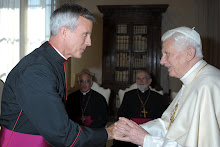The Meaning of the Stained Glass Window behind the Altar at the Chapel of Saints Peter and Paul
As promised I wanted to share some of the background regarding the various symbols that you see in the stained glass depicting the risen Christ and the twelve apostles.
The Risen Christ- of course this image is self explanatory, the artistic idea was to bring together the full imagery of Christ Crucified, Christ on the Eucharistic Altar and Christ Risen and gloriously reigning
The Four Evangelical Figures- These winged figures come from the prophet Ezequiel and the Book of Revelation and have traditionally been associated with the Four Evangelists since at least the 5th century. The Man (Incarnation) represents Matthew traditionally because he begins his Gospel with the human genealogy of Christ, the Lion (Resurrection) represents Mark referring to John the Baptist the Lion in the Desert, the Ox (Passion) represents Luke and calls to mind Luke’s emphasis on the sacrifice of Christ and the Eagle (Ascension) represents John’s Gospel which sores to the heavens with its deeply theological themes.
The Chalice and Loaves of Bread- These images which hover directly over the tabernacle and altar clearly draw us to reflect on the Eucharistic Sacrifice which takes place at the altar at every mass.
The Apostles on either side of the Risen Christ- These chosen ones gather around the resurrected Lord as they gathered with Him at the Last Supper. Because the Chapel is dedicated to Peter and Paul the artists used some license in replacing the image of Judas Iscariot the betrayer with the image of Paul carrying his sword. Paul is traditionally depicted with a sword and a scroll both calling to mind the power of the Word of God.
Looking at the window from top left we begin with Bartholomew (also called Nathaniel) depicted with a knife or spear due to he manner of his death. Tradition says he was flayed alive. Next is Andrew who is represented with the X shaped cross because of the tradition that he died on a cross shaped like an X. Then we see Jude who is depicted with a flame over his head calling to mind his presence at Pentecost. Phillip is depicted holding a loaf of bread he is the apostle who answers Christ at the multiplication of the loaves. James the Younger is depicted with a saw because of the tradition that he was martyred by being thrown from the roof of the temple and his head was sawed off as an expression of hatred and persecution. Finally, at the bottom of the left window is Peter who is presented holding the keys to the kingdom which Christ gave him as the head of the Apostles.
At the top of the right hand window we have Thomas holding a spear because that is how he was martyred. He is also sometimes depicted with a carpenters square because he built the church in India. James the Elder holds a scallop shell symbolic of his great travels across the oceans of the world. Next is John who holds a cup with a serpent because tradition says someone attempted to murder him with poison in the communion cup. Simon is depicted with a fishermen’s net calling to mind the Gospel passage where he and the others are called to be fishers of men. Matthew is depicted with a money bag because he was called away from is tax collecting tables to follow Christ and then we find ourselves back with Paul and the two edged sword of the Word of God.
You may find other symbols and images used as well because there are many traditions concerning the twelve apostles. The artists chose to use the symbols describe above because they have strong roots in the history of the Church,
It is worth noting that the images refer to the ways the apostles lived the Gospel and often the way they died for the Gospel as well.
The next window to be installed in the Chapel will be over the main entry doors. It depicts the Supper of the Lamb which comes from the Apocalyptic Visions in the Book of Revelation.
The windows along the sides of the Chapel will be installed in the coming months and depict the Communion of Saints processing to the altar of the Lord through the ages.
The choir area includes windows depicting St. Cecelia and St. Gregory tradionally saints associated with music and in the side entry vestibule we will have the three Archangels, Michael. Raphael and Gabriel.
Thursday, December 15, 2011
Subscribe to:
Post Comments (Atom)

No comments:
Post a Comment